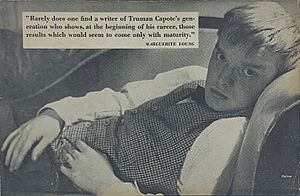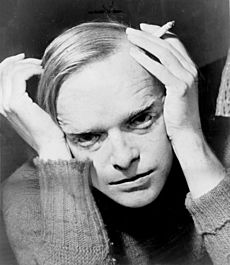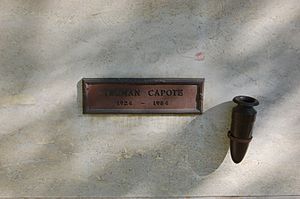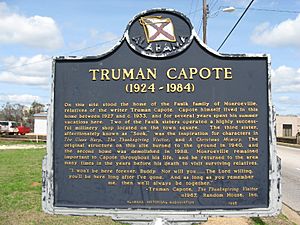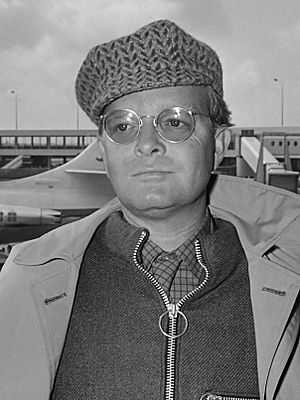Truman Capote facts for kids
Quick facts for kids
Truman Capote
|
|
|---|---|
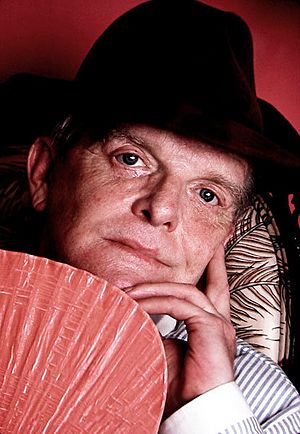
Capote in 1980 by Jack Mitchell
|
|
| Born |
Truman Streckfus Persons
September 30, 1924 New Orleans, Louisiana, U.S.
|
| Died | August 25, 1984 (aged 59) Los Angeles, California, U.S.
|
| Resting place | Westwood Village Memorial Park Cemetery |
| Other names | Truman Garcia Capote |
| Education | Greenwich High School Dwight School |
| Occupation |
|
| Years active | 1942–1984 |
| Movement |
|
| Partner(s) | Jack Dunphy (1948–1984; his death) |
| Signature | |
Truman Garcia Capote (/kəˈpoʊti/ kə-POH-tee; born Truman Streckfus Persons; September 30, 1924 – August 25, 1984) was an American novelist, screenwriter, playwright and actor. Several of his short stories, novels, and plays have been praised as literary classics, including the novella Breakfast at Tiffany's (1958) and the true crime novel In Cold Blood (1966), which he labeled a "non-fiction novel". His works have been adapted into more than 20 films and television dramas.
Capote rose above a childhood troubled by divorce, a long absence from his mother, and multiple migrations. He had discovered his calling as a writer by the time he was eight years old, and he honed his writing ability throughout his childhood. He began his professional career writing short stories. The critical success of "Miriam" (1945) attracted the attention of Random House publisher Bennett Cerf and resulted in a contract to write the novel Other Voices, Other Rooms (1948). Capote earned the most fame with In Cold Blood (1966). Capote spent six years writing the book, aided by his lifelong friend Harper Lee, who wrote To Kill a Mockingbird (1960).
Contents
Early life
He was born in New Orleans, Louisiana, to Lillie Mae Faulk (1905–1954) and salesman Archulus Persons (1897–1981). His parents divorced when he was two, and he was sent to Monroeville, Alabama, where, for the following four to five years, he was raised by his mother's relatives. He formed a fast bond with his mother's distant relative, Nanny Rumbley Faulk, whom Truman called "Sook". "Her face is remarkable – not unlike Lincoln's, craggy like that, and tinted by sun and wind", is how Capote described Sook in "A Christmas Memory" (1956). In Monroeville, Capote was a neighbor and friend of Harper Lee, who would also go on to become an acclaimed author and a lifelong friend of Capote's. Lee's To Kill A Mockingbird likely models Dill's characterization after Capote.
As a lonely child, Capote taught himself to read and write before he entered his first year of school. Capote was often seen at age five carrying his dictionary and notepad, and began writing fiction at age 11. He was given the nickname "Bulldog" around this age.
On Saturdays, he made trips from Monroeville to the nearby city of Mobile on the Gulf Coast, and at one point submitted a short story, "Old Mrs. Busybody", to a children's writing contest sponsored by the Mobile Press Register. Capote received recognition for his early work from The Scholastic Art & Writing Awards in 1936.
In 1932, he moved to New York City to live with his mother and her second husband, José García Capote, a bookkeeper from Union de Reyes, Cuba, who adopted him as his son and renamed him Truman García Capote. Shortly afterward, José was convicted of embezzlement, after which the family was forced to leave its home on Park Avenue.
Of his early days, Capote related, "I was writing really sort of serious when I was about 11. I say seriously in the sense that like other kids go home and practice the violin or the piano or whatever, I used to go home from school every day, and I would write for about three hours. I was obsessed by it." In 1932, he attended the Trinity School in New York City. He then attended St. Joseph Military Academy. In 1939, the Capote family moved to Greenwich, Connecticut, and Truman attended Greenwich High School, where he wrote for both the school's literary journal, The Green Witch, and the school newspaper. When they returned to New York City in 1941, he attended the Franklin School, an Upper West Side private school now known as the Dwight School, and graduated in 1942. That was the end of his formal education.
While still attending Franklin in 1942, Capote began working as a copyboy in the art department at The New Yorker, a job he held for two years before being fired for angering poet Robert Frost. Years later, he reflected, "Not a very grand job, for all it really involved was sorting cartoons and clipping newspapers. Still, I was fortunate to have it, especially since I was determined never to set a studious foot inside a college classroom. I felt that either one was or wasn't a writer, and no combination of professors could influence the outcome. I still think I was correct, at least in my own case." He left his job to live with relatives in Alabama and began writing his first novel, Summer Crossing.
He was called for induction into the armed services during World War II, but he later told a friend that he was "turned down for everything, including the WACS". He later explained that he was found to be "too neurotic".
Friendship with Harper Lee
Capote based the character of Idabel in Other Voices, Other Rooms on his Monroeville, Alabama, neighbor and best friend, Harper Lee. Capote once acknowledged this: "Mr. and Mrs. Lee, Harper Lee's mother and father, lived very near. She was my best friend. Did you ever read her book, To Kill a Mockingbird? I'm a character in that book, which takes place in the same small town in Alabama where we lived. Her father was a lawyer, and she and I used to go to trials all the time as children. We went to the trials instead of going to the movies." After Lee was awarded the Pulitzer Prize in 1961 and Capote published In Cold Blood in 1966, the authors became increasingly distant from each other.
Writing career
Short story phase
Capote began writing short stories from around the age of 8. In 2013, the Swiss publisher Peter Haag discovered 14 unpublished stories, written when Capote was a teenager, in the New York Public Library Archives. Random House published these in 2015, under the title The Early Stories of Truman Capote.
Between 1943 and 1946, Capote wrote a continual flow of short fiction, including "Miriam", "My Side of the Matter", and "Shut a Final Door" (for which he won the O. Henry Award in 1948, at the age of 24). His stories were published in both literary quarterlies and well-known popular magazines, including The Atlantic Monthly, Harper's Bazaar, Harper's Magazine, Mademoiselle, The New Yorker, Prairie Schooner, and Story. In June 1945, "Miriam" was published by Mademoiselle and went on to win a prize, Best First-Published Story, in 1946. In the spring of 1946, Capote was accepted at Yaddo, the artists and writers colony at Saratoga Springs, New York. (He later endorsed Patricia Highsmith as a Yaddo candidate, and she wrote Strangers on a Train while she was there.)
Random House, the publisher of his novel Other Voices, Other Rooms (see below), moved to capitalize on this novel's success with the publication of A Tree of Night and Other Stories in 1949. In addition to "Miriam", this collection also includes "Shut a Final Door", first published in The Atlantic Monthly (August 1947).
After A Tree of Night, Capote published a collection of his travel writings, Local Color (1950), which included nine essays originally published in magazines between 1946 and 1950.
"A Christmas Memory", a largely autobiographical story taking place in the 1930s, was published in Mademoiselle magazine in 1956. It was issued as a hard-cover stand alone edition in 1966 and has since been published in many editions and anthologies.
Posthumously published early novel
Some time in the 1940s, Capote wrote a novel set in New York City about the summer romance of a socialite and a parking lot attendant. Capote later claimed to have destroyed the manuscript of this novel; but 20 years after his death, in 2004, it came to light that the manuscript had been retrieved from the trash back in 1950 by a house sitter at an apartment formerly occupied by Capote. The novel was published in 2006 by Random House under the title Summer Crossing.
As of 2013, the film rights to Summer Crossing had been purchased by actress Scarlett Johansson, who reportedly planned to direct the adaptation.
First novel, Other Voices, Other Rooms
The critical success of one of his short stories, "Miriam" (1945), attracted the attention of the publisher Bennett Cerf, resulting in a contract with Random House to write a novel. With an advance of $1,500, Capote returned to Monroeville and began Other Voices, Other Rooms, continuing to work on the manuscript in New Orleans, Saratoga Springs, New York, and North Carolina, eventually completing it in Nantucket, Massachusetts. It was published in 1948. Capote described this symbolic tale as "a poetic explosion in highly suppressed emotion". The novel is a semi-autobiographical refraction of Capote's Alabama childhood. Decades later, writing in The Dogs Bark (1973), he commented:
- Other Voices, Other Rooms was an attempt to exorcise demons, an unconscious, altogether intuitive attempt, for I was not aware, except for a few incidents and descriptions, of its being in any serious degree autobiographical. Rereading it now, I find such self-deception unpardonable.
The story focuses on 13-year-old Joel Knox following the loss of his mother. Joel is sent from New Orleans to live with his father, who abandoned him at the time of his birth. Arriving at Skully's Landing, a vast, decaying mansion in rural Alabama, Joel meets his sullen stepmother Amy, debauched Randolph, and defiant Idabel, a girl who becomes his friend. Despite Joel's queries, the whereabouts of his father remain a mystery. When he finally is allowed to see his father, Joel is stunned to find he is a quadriplegic, having tumbled down a flight of stairs after being inadvertently shot by Randolph. Joel runs away with Idabel but catches pneumonia and eventually returns to the Landing, where he is nursed back to health by Randolph.
Harold Halma photograph
Other Voices, Other Rooms made The New York Times bestseller list and stayed there for nine weeks, selling more than 26,000 copies. The promotion and controversy surrounding this novel catapulted Capote to fame. A 1947 Harold Halma photograph used to promote the book showed a reclining Capote gazing fiercely into the camera. Gerald Clarke, in Capote: A Biography (1988), wrote, "The famous photograph: Harold Halma's picture on the dustjacket of Other Voices, Other Rooms (1948) caused as much comment and controversy as the prose inside. Truman claimed that the camera had caught him off guard, but in fact he had posed himself and was responsible for both the picture and the publicity." The photo made a huge impression on the 20-year-old Andy Warhol, who often talked about the picture and wrote fan letters to Capote. When Warhol moved to New York in 1949, he made numerous attempts to meet Capote, and Warhol's fascination with the author led to Warhol's first New York one-man show, Fifteen Drawings Based on the Writings of Truman Capote at the Hugo Gallery (June 16 – July 3, 1952).
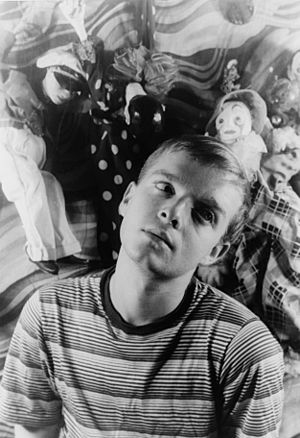
When the picture was reprinted along with reviews in magazines and newspapers, some readers were amused, but others were outraged and offended. The Los Angeles Times reported that Capote looked "as if he were dreamily contemplating some outrage against conventional morality". The novelist Merle Miller issued a complaint about the picture at a publishing forum, and the photo of "Truman Remote" was satirized in the third issue of Mad (making Capote one of the first four celebrities to be spoofed in Mad). The humorist Max Shulman struck an identical pose for the dustjacket photo on his collection, Max Shulman's Large Economy Size (1948). The Broadway stage revue New Faces (and the subsequent film version) featured a skit in which Ronny Graham parodied Capote, deliberately copying his pose in the Halma photo. Random House featured the Halma photo in its "This is Truman Capote" ads, and large blowups were displayed in bookstore windows. Walking on Fifth Avenue, Halma overheard two middle-aged women looking at a Capote blowup in the window of a bookstore. When one woman said, "I'm telling you: he's just young", the other woman responded, "And I'm telling you, if he isn't young, he's dangerous!" Capote delighted in retelling this anecdote.
Stage, screen, and magazine work
In the early 1950s, Capote took on Broadway and films, adapting his 1951 novella, The Grass Harp, into a 1952 play of the same name (later a 1971 musical and a 1995 film), followed by the musical House of Flowers (1954), which spawned the song "A Sleepin' Bee". Capote co-wrote with John Huston the screenplay for Huston's film Beat the Devil (1953). Traveling through the Soviet Union with a touring production of Porgy and Bess, he produced a series of articles for The New Yorker that became his first book-length work of nonfiction, The Muses Are Heard (1956).
In this period he also wrote an autobiographical essay for Holiday Magazine—one of his personal favorites—about his life in Brooklyn Heights in the late 1950s, entitled Brooklyn Heights: A Personal Memoir (1959). In November 2015, The Little Bookroom issued a new coffee-table edition of that work, which includes David Attie's previously-unpublished portraits of Capote as well as Attie's street photography taken in connection with the essay, entitled Brooklyn: A Personal Memoir, With The Lost Photographs of David Attie. This edition was well-reviewed in America and overseas, and was also a finalist for a 2016 Indie Book Award.
Breakfast at Tiffany's
Breakfast at Tiffany's: A Short Novel and Three Stories (1958) brought together the title novella and three shorter tales: "House of Flowers", "A Diamond Guitar" and "A Christmas Memory". The heroine of Breakfast at Tiffany's, Holly Golightly, became one of Capote's best known creations, and the book's prose style prompted Norman Mailer to call Capote "the most perfect writer of my generation".
The novella itself was originally supposed to be published in Harper's Bazaar's July 1958 issue, several months before its publication in book form by Random House. The publisher of Harper's Bazaar, the Hearst Corporation, began demanding changes to Capote's tart language, which he reluctantly made because he had liked the photos by David Attie and the design work by Harper's art director Alexey Brodovitch that were to accompany the text. But despite his compliance, Hearst ordered Harper's not to run the novella anyway. Its language and subject matter were still deemed "not suitable", and there was concern that Tiffany's, a major advertiser, would react negatively. An outraged Capote resold the novella to Esquire for its November 1958 issue; by his own account, he told Esquire he would only be interested in doing so if Attie's original series of photos was included, but to his disappointment, the magazine ran just a single full-page image of Attie's (another was later used as the cover of at least one paperback edition of the novella). The novella was published by Random House shortly afterwards.
In Cold Blood
In Cold Blood was published in 1966 by Random House after having been serialized in The New Yorker. The "nonfiction novel", as Capote labeled it, brought him literary acclaim and became an international bestseller, but Capote would never complete another novel after it.
Celebrity
Capote was openly gay. He was well known for his distinctive, high-pitched voice and odd vocal mannerisms, his offbeat manner of dress, and his fabrications. He often claimed to know intimately people whom he had in fact never met, such as Greta Garbo.
Years following In Cold Blood
Now more sought after than ever, Capote wrote occasional brief articles for magazines, and also entrenched himself more deeply in the world of the jet set. Gore Vidal once observed, "Truman Capote has tried, with some success, to get into a world that I have tried, with some success, to get out of."
In the late 1960s, he became friendly with Lee Radziwill, the sister of Jacqueline Kennedy Onassis. Radziwill was an aspiring actress and had been panned for her performance in a production of The Philadelphia Story in Chicago. Capote was commissioned to write the teleplay for a 1967 television production starring Radziwill: an adaptation of the classic Otto Preminger film Laura (1944). The adaptation, and Radziwill's performance in particular, received indifferent reviews and poor ratings; arguably, it was Capote's first major professional setback. Radziwill supplanted the older Babe Paley as Capote's primary female companion in public throughout the better part of the 1970s.
On November 28, 1966, in honor of The Washington Post publisher Katharine Graham, Capote hosted a now-legendary masked ball, called the Black and White Ball, in the Grand Ballroom of New York City's Plaza Hotel. It was considered the social event of not only that season but of many to follow, with The New York Times and other publications giving it considerable coverage. Capote dangled the prized invitations for months, snubbing early supporters like fellow Southern writer Carson McCullers as he determined who was "in" and who was "out".
Despite the assertion earlier in life that one "lost an IQ point for every year spent on the West Coast", he purchased a home in Palm Springs and began to indulge in a more aimless life.
Capote never finished another novel after In Cold Blood. The dearth of new prose and other failures, including a rejected screenplay for Paramount Pictures's 1974 adaptation of The Great Gatsby, were counteracted by Capote's frequenting of the talk show circuit. In 1972, Capote accompanied The Rolling Stones on their first American tour since 1969 as a correspondent for Rolling Stone. He ultimately refused to write the article, so the magazine recouped its interests by publishing in April 1973 an interview of the author conducted by Andy Warhol. A collection of previously published essays and reportage, The Dogs Bark: Public People and Private Places, appeared later that year.
Answered Prayers
Through his jet set social life Capote had been gathering observations for a tell-all novel, Answered Prayers (eventually to be published as Answered Prayers: The Unfinished Novel). The book, which had been in the planning stages since 1958, was intended to be the American equivalent of Marcel Proust's In Search of Lost Time and a culmination of the "nonfiction novel" format. Initially scheduled for publication in 1968, the novel was eventually delayed, at Capote's insistence, to 1972. Because of the delay, he was forced to return money received for the film rights to 20th Century Fox. Capote spoke about the novel in interviews, but continued to postpone the delivery date.
Capote permitted Esquire to publish four chapters of the unfinished novel in 1975 and 1976. The first to appear, "Mojave", ran as a self-contained short story and was favorably received, but the second, "La Côte Basque 1965", based in part on the dysfunctional personal lives of Capote's friends William S. Paley and Babe Paley, generated controversy.
"La Côte Basque 1965"
"La Côte Basque 1965" was published as an individual chapter in Esquire magazine in November 1975. Many of Capote's circle of high-society female friends, whom he nicknamed his "swans", were featured in the text, some under pseudonyms and others by their real names.
Last years
Andy Warhol, who had looked up to the writer as a mentor in his early days in New York and often partied with Capote at Studio 54, agreed to paint Capote's portrait as "a personal gift" in exchange for Capote's contributing short pieces to Warhol's Interview magazine every month for a year in the form of a column, Conversations with Capote. Initially the pieces were to consist of tape-recorded conversations, but soon Capote eschewed the tape recorder in favor of semi-fictionalized "conversational portraits". These pieces formed the basis for the bestselling Music for Chameleons (1980).
Capote underwent a facelift, lost weight and experimented with hair transplants.
After the revocation of his driver's license (the result of speeding near his Long Island residence) and a hallucination-based seizure in 1980 that required hospitalization, Capote became fairly reclusive. On the rare occasions when he was lucid, he continued to promote Answered Prayers as being nearly complete and was reportedly planning a reprise of the Black and White Ball to be held either in Los Angeles or a more exotic locale in South America. On a few occasions, he was still able to write. In 1982, a new short story, "One Christmas", appeared in the December issue of Ladies' Home Journal; the following year it became, like its predecessors A Christmas Memory and The Thanksgiving Visitor, a holiday gift book.
Death
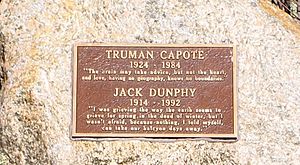
Capote died in Bel Air, Los Angeles, on August 25, 1984. According to the coroner's report, the cause of death was "liver disease complicated by phlebitis". He died at the home of his old friend Joanne Carson, ex-wife of late-night TV host Johnny Carson, on whose program Capote had been a frequent guest. Gore Vidal responded to news of Capote's death by calling it "a wise career move".
Capote was cremated and his remains were reportedly divided between Carson and Jack Dunphy (although Dunphy maintained that he received all the ashes). Carson said she kept the ashes in an urn in the room where he died. Those ashes were reported stolen during a Halloween party in 1988 along with $200,000 in jewels but were then returned six days later, having been found in a coiled-up garden hose on the back steps of Carson's Bel Air home. The ashes were reportedly stolen again when taken to a production of Tru but the thief was caught before leaving the theatre. Carson bought a crypt at Westwood Village Memorial Park Cemetery in Los Angeles. In 2013 the producers offered to fly Carson and the ashes to New York for a Broadway production of Breakfast at Tiffany's. Carson declined the offer. Dunphy died in 1992, and in 1994, both his and Capote's ashes were reportedly scattered at Crooked Pond, between Bridgehampton, New York, and Sag Harbor, New York on Long Island, close to Sagaponack, New York, where the two had maintained a property with individual houses for many years. Crooked Pond was chosen because money from the estate of Dunphy and Capote was donated to the Nature Conservancy, which in turn used it to buy 20 acres around Crooked Pond in an area called "Long Pond Greenbelt". A stone marker indicates the spot where their mingled ashes were thrown into the pond. In 2016, some of Capote's ashes previously owned by Joanne Carson were auctioned by Julien's Auctions.
Capote also maintained the property in Palm Springs, a condominium in Switzerland that was mostly occupied by Dunphy seasonally, and a primary residence at 860 United Nations Plaza in New York City. Capote's will provided that after Dunphy's death, a literary trust would be established, sustained by revenues from Capote's works, to fund various literary prizes, fellowships and scholarships, including the Truman Capote Award for Literary Criticism in Memory of Newton Arvin, commemorating not only Capote but also his friend Newton Arvin, the Smith College professor and critic who lost his job after his homosexuality was revealed. As such, the Truman Capote Literary Trust was established in 1994, two years after Dunphy's death.
Permanent hometown exhibit
Capote's childhood is the focus of a permanent exhibit in Monroeville, Alabama's Old Courthouse Museum, covering his life in Monroeville with his Faulk cousins and how those early years are reflected in his writing. The exhibit brings together photos, letters and memorabilia to paint a portrait of Capote's early life in Monroeville. The collection comprises 12 handwritten letters (1940s–60s) from Capote to his favorite aunt, Mary Ida Carter (Jennings' mother). Many of the items in the collection belonged to his mother and Virginia Hurd Faulk, Carter's cousin with whom Capote lived as a child.
Capote on film
- In 1961, Capote's novel Breakfast at Tiffany's (1958), about a flamboyant New York party girl named Holly Golightly, was filmed by director Blake Edwards and starred Audrey Hepburn in what many consider her defining role, though Capote never approved of the many changes to the story, made to appeal to mass audiences.
- Capote's childhood experiences are captured in the memoir A Christmas Memory (1956), which he adapted for television and narrated. Directed by Frank Perry, it aired on December 21, 1966, on ABC Stage 67, and featured Geraldine Page in an Emmy Award-winning performance.
- When Richard Brooks directed In Cold Blood, the 1967 adaptation of the novel, with Robert Blake and Scott Wilson, he filmed at the actual Clutter house and other Holcomb, Kansas, locations.
- Capote narrated his The Thanksgiving Visitor (1967), a sequel to A Christmas Memory, filmed by Frank Perry in Pike Road, Alabama. Geraldine Page again won an Emmy for her performance in this hour-long teleplay.
- The ABC Stage 67 teleplay was later incorporated into Perry's 1969 anthology film Trilogy (aka Truman Capote's Trilogy), which also includes adaptations of "Miriam" and "Among the Paths to Eden".
- Neil Simon's murder mystery spoof Murder by Death (1976) provided Capote's main role as an actor, portraying reclusive millionaire Lionel Twain who invites the world's leading detectives together to a dinner party to have them solve a murder. The performance brought him a Golden Globe Award nomination (Best Acting Debut in a Motion Picture). Early in the film, it is alleged that Twain has ten fingers but no pinkies. In truth, Capote's pinkie fingers were unusually large. In the film, Capote's character is highly critical of detective fiction from the likes of Agatha Christie and Dashiell Hammett.
- Woody Allen's Annie Hall (1977) includes a scene in which Alvy (Allen) and Annie (Diane Keaton) are observing passersby in the park. Alvy comments, "Oh, there's the winner of the Truman Capote Look-Alike Contest". The passerby is actually Truman Capote (who appeared in the film uncredited).
- Other Voices, Other Rooms (1995) stars David Speck in the lead role of Joel Sansom.
- In 1995, Capote's novella The Grass Harp (1951), which he later turned into a 1952 play, was made into a film version with a screenplay by Stirling Silliphant and directed by Charles Matthau, Walter Matthau's son. This story is somewhat autobiographical of Capote's childhood in Alabama.
- Anthony Edwards and Eric Roberts headed the cast of the 1996 In Cold Blood miniseries, directed by Jonathan Kaplan.
- The TV movie Truman Capote's A Christmas Memory (1997), with Patty Duke and Piper Laurie, was a remake of the 1966 television show, directed by Glenn Jordan.
- In 2002, director Mark Medoff brought to film Capote's short story "Children on Their Birthdays", another look back at a small-town Alabama childhood.
Documentaries
- With Love from Truman (1966), a 29-minute documentary by David and Albert Maysles and Charlotte Zwerin, shows a Newsweek reporter interviewing Capote at his beachfront home in Long Island. Capote talks about In Cold Blood, his relationship with the murderers, and his coverage of the trial. He is also seen taking Alvin Dewey and his wife around New York City for the first time. Originally titled A Visit with Truman Capote, this film was commissioned by National Educational Television and shown on the NET network.
- Truman Capote: The Tiny Terror (original airdate December 17, 1997) is a documentary that aired as part of A&E's Biography series, followed by a 2005 DVD release.
- The Capote Tapes (2019), directed by Ebs Burnough. Using "never-before-heard" audio archives and interviews with Capote and his associates, the film centers around Capote's unfinished novel, Answered Prayers.
Portrayals of Capote
Theater
- In 1990, Robert Morse received both a Tony and a Drama Desk Award for his portrayal of Capote in the one-man show Tru.
- In 1994, actor-writer Bob Kingdom created the one-man theatre piece The Truman Capote Talk Show, in which he played Capote looking back over his life. Originally performed at the Lyric Studio Theatre, Hammersmith, London, the show has toured widely within the UK and internationally.
- In 1996, Louis Negin appeared in a Toronto production of Tru.
Film
- In 54 (1998), with Louis Negin in the role of Capote, a reference is made to Capote just having had a face lift, and the song "Knock on Wood" is dedicated to him.
- In Isn't She Great (2000), Sam Street is seen briefly as Capote. The film is a biographical comedy-drama about Jacqueline Susann.
- In The Audrey Hepburn Story (2000), Michael J. Burg played Capote; and again in The Hoax (2006) (in deleted scenes).
- In Capote (2005), Capote was played by Philip Seymour Hoffman. The biopic is the dramatic feature debut of director Bennett Miller. Spanning the years Capote spent researching and writing In Cold Blood, the film depicts Capote's conflict between his compassion for his subjects and self-absorbed obsession with finishing the book. Capote garnered much critical acclaim when it was released (September 30, 2005, in the US and February 24, 2006, in the UK). Dan Futterman's screenplay was based on the book Capote: A Biography by Gerald Clarke (1988). Capote received five Academy Award nominations: Best Picture, Best Director, Best Adapted Screenplay, Best Actor and Best Supporting Actress. Hoffman's performance earned him many awards, including an Oscar for Best Actor in a Leading Role, a BAFTA Award, a Golden Globe Award, a Screen Actors Guild Award, and an Independent Spirit Award.
- Infamous (2006), directed by Douglas McGrath and starring Toby Jones as Capote and Sandra Bullock as Harper Lee, is an adaptation of George Plimpton's Truman Capote: In Which Various Friends, Enemies, Acquaintances and Detractors Recall His Turbulent Career (1997). On the DVD commentary track, McGrath admits to the occasional scene being compiled and drawn together by using the truth and blended with his own "imagination" of how the actual story evolved.
Television
- In 1992, Robert Morse recreated his role as Capote in the play Tru for the PBS series American Playhouse and won an Emmy Award for his performance.
- Michael J. Burg appeared as Capote in an episode of ABC-TV's short-lived series Life on Mars (2009).
Literature
- The Swans of Fifth Avenue: A Novel (2016) by Melanie Benjamin tells the story of the evolution of Capote's friendship with Babe Paley and the New York "swans", and his fallout from high society after the publication of "La Côte Basque 1965".
Discography
- House of Flowers (1954) Columbia 2320. (LP) Broadway production. Saint Subber presents Truman Capote and Harold Arlen's House of Flowers, starring Pearl Bailey. Directed by Peter Brook with musical numbers by Herbert Ross. Columbia 12" LP, Stereo-OS-2320. Electronically reprocessed for stereo.
- Children on Their Birthdays (1955) Columbia Literary Series ML 4761 12" LP. Reading by Capote.
- House of Flowers (1955) Columbia Masterworks 12508. (LP) Read by the Author.
- A Christmas Memory (1959) United Artists UAL 9001. (LP) Truman Capote reading his A Christmas Memory.
- In Cold Blood (1966) RCA Victor Red Seal monophonic VDM-110. (LP) Truman Capote reads scenes from In Cold Blood.
- The Thanksgiving Visitor (1967) United Artists UAS 6682. (LP) Truman Capote reading his The Thanksgiving Visitor.
- Capote (2006) RCA, Film Soundtrack. Includes complete 1966 RCA recording Truman Capote reads scenes from In Cold Blood
- In Cold Blood (2006) Random House unabridged on 12 CDs. Read by Scott Brick.
Works
| Year | Title | Notes |
|---|---|---|
| 1945 | "Miriam" | Short story; published in Mademoiselle |
| 1948 | Other Voices, Other Rooms | Novel |
| 1949 | A Tree of Night and Other Stories | Collection of short stories |
| 1950 | "House of Flowers" | Short story; the first chapter was published in Botteghe Oscure in 1950 and in Harper's Bazaar in 1951 |
| 1950 | Local Color | Book; collection of European travel essays |
| 1951 | The Grass Harp | Novel |
| 1952 | The Grass Harp | Play |
| 1953 | Beat the Devil | Original screenplay |
| Terminal Station | Screenplay (dialogue only) | |
| 1954 | House of Flowers | Broadway musical |
| 1955 | "Carmen Therezinha Solbiati – So Chic" | Short story ( Brazilian jet-setter Carmen Mayrink Veiga ); published in Vogue in 1956 |
| 1956 | The Muses Are Heard | Nonfiction |
| 1956 | "A Christmas Memory" | Short story; published in Mademoiselle |
| 1957 | "The Duke in His Domain" | Profile of Marlon Brando; published in The New Yorker; Republished in Life Stories: Profiles from The New Yorker in 2001 |
| 1958 | Breakfast at Tiffany's | Novella |
| 1959 | "Brooklyn Heights: A Personal Memoir" | Autobiographical essay, photos by David Attie; published in the February 1959 issue of Holiday Magazine and later as "A House On The Heights" in 2002 (see below) |
| 1959 | Observations | Collaborative art and photography book; photos by Richard Avedon, comments by Truman Capote and design by Alexey Brodovitch |
| 1960 | The Innocents | Screenplay based on The Turn of the Screw by Henry James; 1962 Edgar Award, from the Mystery Writers of America, to Capote and William Archibald for Best Motion Picture Screenplay |
| 1963 | Selected Writings of Truman Capote | Midcareer retrospective anthology; fiction and nonfiction |
| 1964 | A short story appeared in Seventeen magazine | |
| 1965 | In Cold Blood | "Nonfiction novel"; Capote's second Edgar Award (1966), for Best Fact Crime book |
| 1967 | "A Christmas Memory" | Best Screenplay Emmy Award; ABC TV movie |
| 1968 | The Thanksgiving Visitor | Short story published as a gift book |
| Laura | Television film; original screenplay | |
| 1973 | The Dogs Bark | Collection of travel articles and personal sketches |
| 1975 | "Mojave" and "La Cote Basque, 1965" | Short stories published in Esquire |
| 1976 | "Unspoiled Monsters" and "Kate McCloud" | Short stories published in Esquire |
| 1980 | Music for Chameleons | Collection of short works mixing fiction and nonfiction |
| 1983 | "One Christmas" | Short story published as a gift book |
| 1986 | Answered Prayers: The Unfinished Novel | Published posthumously |
| 1987 | A Capote Reader | Omnibus edition containing most of Capote's shorter works, fiction and nonfiction |
| 2002 | A House On The Heights | Book edition of Capote's essay, "Brooklyn Heights: A Personal Memoir (1959), with a new introduction by George Plimpton |
| 2004 | The Complete Stories of Truman Capote | Anthology of twenty short stories |
| 2004 | Too Brief a Treat: The Letters of Truman Capote | Edited by Capote biographer Gerald Clarke |
| 2006 | Summer Crossing | Novel; Published by Random House |
| 2007 | Portraits and Observations: The Essays of Truman Capote | Published by Random House |
| 2015 | The Early Stories of Truman Capote | Published by Random House; 14 previously unpublished stories, written by Capote when he was a teenager, discovered in the New York Public Library Archives in 2013. |
See also
 In Spanish: Truman Capote para niños
In Spanish: Truman Capote para niños


